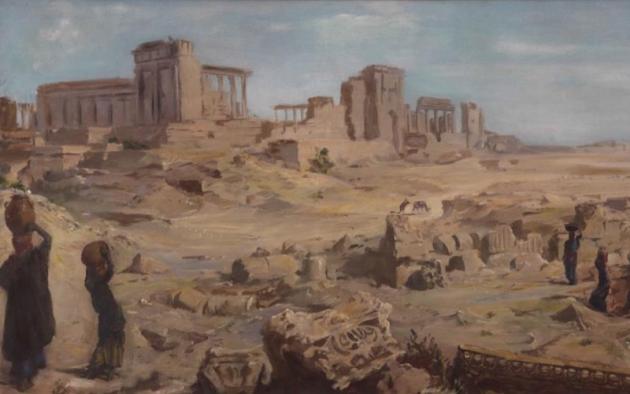The great Syrian ruins of Palmyra, recently damaged by ISIS, is depicted in its former glory, as viewed in the early 1930s by the Russian artist, Alexander Yakovlev (1887–1938), in his masterpiece, Palmyra, on sale at MacDougall’s Russian Art Auction 8 June 2016.
Yakovlev shows Arab women carrying loads through the ruins of ancient Palmyra, once the most beautiful town in the Roman provinces, which astonished people of the time with its magnificent temples, tombs and colonnades. Yakovlev had heard about the historical monuments of classical Palmyra while still a student at the Imperial Academy of Arts. When he saw it with his own eyes, he immediately recorded his impression of “unending rows of columns punctuated in places by arches or ruined temples.”
Orientalist themes are also represented in the 8 June 2016 sale at MacDougall’s, by three important canvasses by Alexei Grishenko (1883–1977), created during his stay in Constantinople in 1920, his first stop on escape from revolutionary Russia: Prayer Time. Constantinople, Street in Constantinople and Sailing Boats. Two works by Richard Zommer (1866–1939) continue the Orientalist theme: Market Place in Central Asia and In the Mountains of Alatau, showing Central Asian images from the Russian Empire.
The sale also features a pair of Vinogradovs discovered in South Africa. The owner’s grandfather escaped from Russia in 1918. While marketing in Riga in 1935 he acquired the Vinogradov paintings. The canvasses have stayed in the same family since then, moving with them to South Africa, giving the works exceptional provenance.
The two canvasses belong to Vinogradov’s renowned series of works from 1928 to 1929, dedicated to the age-old and exceedingly beautiful Pskovo-Pechersky Monastery of the Holy Dormition. The canvasses embodied Russia for the collector, whose Swiss father spent close to two decades, representing the famous Swiss pharmaceutical company Roche in Saint Petersburg, 1900 to 1918.
A rare early work by Wassily Kandinsky is also featured in MacDougall’s Russian Art Auction, 8 June 2016. Rural Landscape (£280,000-350,000) demonstrates that the celebrated founder of abstract art began as a figurative painter. It was painted in the autumn of 1903, during a brief visit the artist made from Munich to the Russian village of Vasilyevskoye, where the artist lived following his marriage.
The auction is a unique opportunity to acquire the only version of the Semiradksy’s large-scale preparatory studies for his most famous painting – Leading Light of Christianity. Nero’s Torches £400,000–500,000 – that still remains in private hands. It shows human torches of Christians martyred by Emperor Niro. The artist explained that the light would “illuminate the most despicable of orgies. Yet these very same torches have dispelled the darkness of the pagan world”.
Ivan Aivazovsky, Shipwreck survivors are an important theme for the great Russian-Armenian seascape painter Aivazovsky, of which The Survivor (£450,000–600,000) is a fine example. A highlight of MacDougall’s 8 June auction is an exceptional work by the great Georgian artist Lado Gudiashvili: The Legend of the Founding of Tbilisi. (£200,000 to 250,000). The work, painted in the 1940s, celebrates the Golden Age of Georgia. The section of more recent art, is led by a masterpiece by Yuri Pimenov, Dressing Room at the Bolshoi Theatre, from 1972 (£130,000–180,000)
The auction also includes fine works of Soviet porcelain in the Works of Art section. And following on from MacDougall’s inaugural photography auction held 21 May there will be a further group of important classical Russian photographs.
Image: Alexander Yakovlev (1887–1938), Palmyra (detail)

